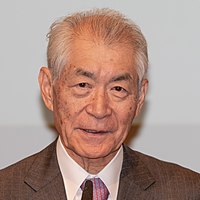Tasuku Honjo
[3] He is also known for his molecular identification of cytokines: IL-4 and IL-5,[4] as well as the discovery of activation-induced cytidine deaminase (AID) that is essential for class switch recombination and somatic hypermutation.
[10] During the COVID-19 pandemic, a disputed claim that Honjo believed that the novel coronavirus had been "manufactured" by a laboratory in the Chinese city of Wuhan was widely disseminated on the internet in many languages.
[11] The BBC Reality Check team reported that, "In a statement published on the website of Kyoto University, he said he was 'greatly saddened' that his name had been used to spread 'false accusations and misinformation'.
In 1992, Honjo first identified PD-1 as an inducible gene on activated T-lymphocytes, and this discovery significantly contributed to the establishment of cancer immunotherapy principle by PD-1 blockade.
In 2016, he won the Kyoto Prize in Basic Sciences for "Discovery of the Mechanism Responsible for the Functional Diversification of Antibodies, Immunoregulatory Molecules and Clinical Applications of PD-1".



